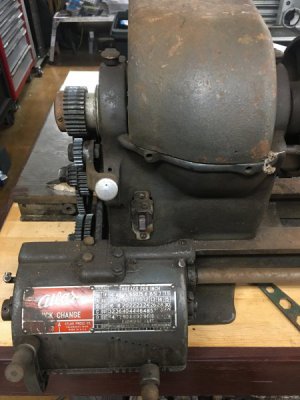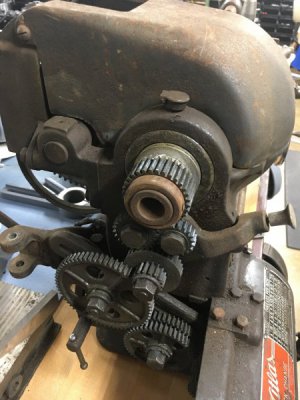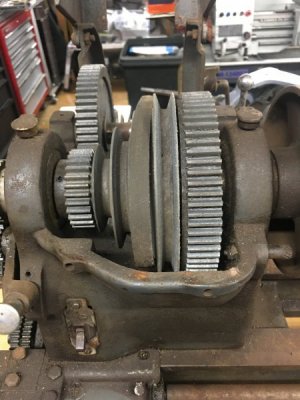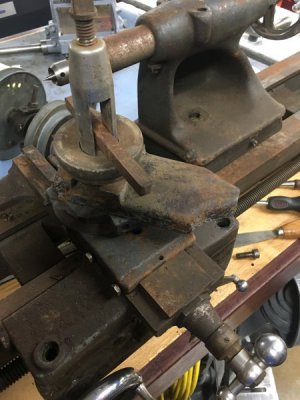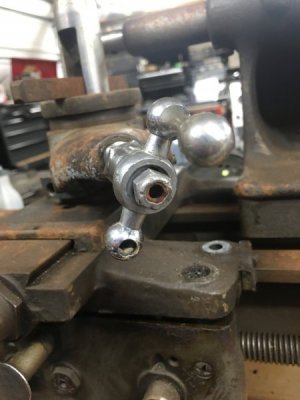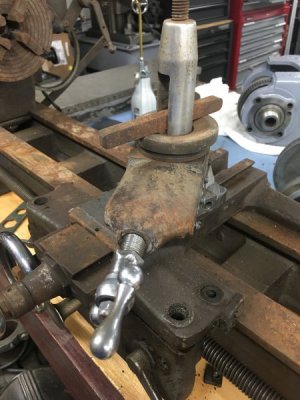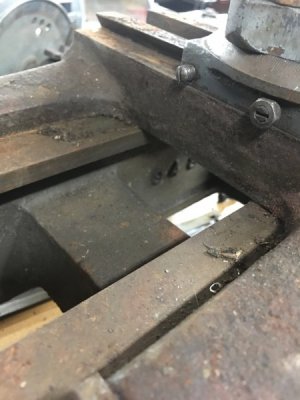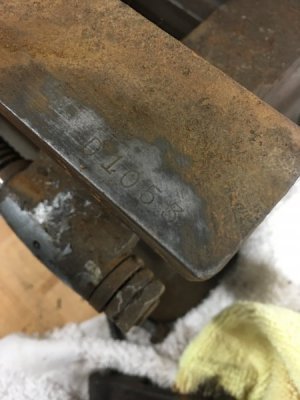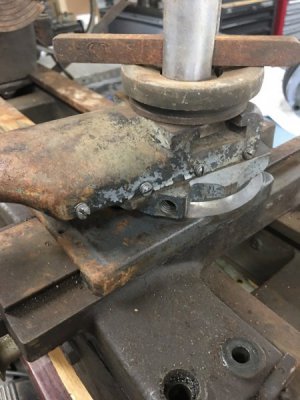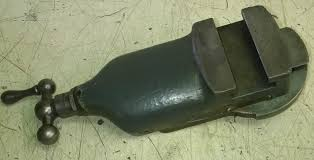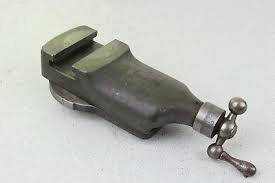-
Welcome back Guest! Did you know you can mentor other members here at H-M? If not, please check out our Relaunch of Hobby Machinist Mentoring Program!
You are using an out of date browser. It may not display this or other websites correctly.
You should upgrade or use an alternative browser.
You should upgrade or use an alternative browser.
can anyone help me identify this Atlas and year it was made? 12x48
- Thread starter GunMonkey
- Start date
- Joined
- Jan 28, 2011
- Messages
- 3,585
Atlas for sure. Timken bearings, horizontal countershaft version. Appears to be a more of 10” based upon that top slide. Like you, the top slide looks different, I have never seen one like this before, but 70 years ago who knows. Has the F series Power cross-feed saddle/carriage.
Thanks pdentrem.
The spindle center and tailstock line up and both appear to be original to the machine. At first glance the lathe looks in poor shape. I could not read the QC badge. I took a damp paper towel and wiped the badge and it looked like new. I rubbed a couple other spots on the lathe and the original paint is there and in good condition. The only area where paint is in poor condition seems to be the compound. The paint remaining on the compound and slide seem to match the rest of the lathe. The ways seem to have a coat of oil on them under the rust. It think most of the rust is from steel dust on the surface as the lathe was primarily used for grinding. The steady rest and follower rest were new and unused in a drawer, the follower rest was wrapped in the original instruction manual but the paper turned to dust as I removed it and I couldn't get a year off it. From what Ive read the 10" and 12" used the same bed casting (this one is a 948). The tailstocks were also common with the 12 inch from what Ive seen but have a riser. I really knew little about the Atlas lathes until a couple days ago when I picked this little guy up.
The bearings sound a little rough. Any idea of a good reasonably priced replacement bearing? The lathe also had a milling attanchment and he had the atlas tool post grinder, several dumore grinders and maybe a dozen random grinders and modified dremel type tools setup for grinding with it. Im thinking of using it primarily for grinding work after cleaning it up. The original motor was on it and plugged in. Each wire is cloth wrapped and they are twisted together with a 2 prong plug. The motor kind of scares me as the cover was open on it and it had a few metal chips that had entered the open cover hole.
I'd love to hear if anyone has input on bearing size and replacement source or brand , Model #, year made, if the compound is correct or not or anything else that might help me get it going.
The spindle center and tailstock line up and both appear to be original to the machine. At first glance the lathe looks in poor shape. I could not read the QC badge. I took a damp paper towel and wiped the badge and it looked like new. I rubbed a couple other spots on the lathe and the original paint is there and in good condition. The only area where paint is in poor condition seems to be the compound. The paint remaining on the compound and slide seem to match the rest of the lathe. The ways seem to have a coat of oil on them under the rust. It think most of the rust is from steel dust on the surface as the lathe was primarily used for grinding. The steady rest and follower rest were new and unused in a drawer, the follower rest was wrapped in the original instruction manual but the paper turned to dust as I removed it and I couldn't get a year off it. From what Ive read the 10" and 12" used the same bed casting (this one is a 948). The tailstocks were also common with the 12 inch from what Ive seen but have a riser. I really knew little about the Atlas lathes until a couple days ago when I picked this little guy up.
The bearings sound a little rough. Any idea of a good reasonably priced replacement bearing? The lathe also had a milling attanchment and he had the atlas tool post grinder, several dumore grinders and maybe a dozen random grinders and modified dremel type tools setup for grinding with it. Im thinking of using it primarily for grinding work after cleaning it up. The original motor was on it and plugged in. Each wire is cloth wrapped and they are twisted together with a 2 prong plug. The motor kind of scares me as the cover was open on it and it had a few metal chips that had entered the open cover hole.
I'd love to hear if anyone has input on bearing size and replacement source or brand , Model #, year made, if the compound is correct or not or anything else that might help me get it going.
- Joined
- Dec 25, 2011
- Messages
- 10,552
First, the 12" tailstock doesn't have a riser. The casting is just 1" taller than the 10" one. Both use the same 10D-6 base. However, the tailstock only has a single web at left and right side. It looks like the ones off of the 12" and the 10D and earlier. All of the known 10F photos have one on the left and two on the right. Please measure the vertical distance from top of bed to center of the ram.
While Serial Number 1053 is consistent with late 1948 or 1949, the "D" in front of it would mean that it is off of a 10D from about 1937. How about adding a photo of the leg under the tailstock end of the bed?
The belt cover looks like the one off of the 101.07383 and none of the catalog photos up through 1952 (which is the latest catalog to turn up) show a smooth front headstock with the quadrant for the three indexing holes for the FWD-OFF-REV tumbler cast into the headstock. Both of the parts manuals on the three known QCGB models show either a bolt-on quadrant or no quadrant. So if it is a 10" headstock, you lucked out. Also, all known headstock photos from 1942 on show a rectangular area pushed out of the front of the headstock onto which a rectangular plate is attached to hold the original bat handle toggle switch for the motor. That isn't really an issue, though it does hurt the identification.
Does anyone else here have a QC model that has those index pin holes as part of the headstock casting??
Finally, although I haven't any current sources for spindle bearings, the fact that you stuck the word "reasonably" in front of "priced" pretty much guarantees that you are going to be flabbergasted when you get a few quotes. Most new owners of old lathes (regardless of badge) seem to think that just because the machine is old, the prices for new parts are still going to be old as well. Unfortunately, prices for new parts are going to cost what new parts cost today. Attached is a PDF file showing the Timken numbers for the bearings (this file is also available in Downloads but because of what it costs us every month to store files and photos, access to Downloads requires Donor status).
On the questions about the Compound Slide, yours isn't a 12" as on it, the mounting surface for the tool post, etc., is raised above the rest of the slide by about 1". Yours looks like a standard 10F slide that someone has carefully ground down the top of a little. Normally, the flat surface for the tool post is just a little lower than the top of the original casting, and new owners who mostly quickly add a QCTP (Quick Change Tool Post) find that they must machine the flat farther towards the rear in order to install the TP properly. So the good news is that it may have already been done to yours, although it still has part of the lantern style TP present. And otherwise, aside from missing the two square head lock screws and probably the beveled locking pins plus the lock nuts on all of the gib screws, the compound slide looks OK.
While Serial Number 1053 is consistent with late 1948 or 1949, the "D" in front of it would mean that it is off of a 10D from about 1937. How about adding a photo of the leg under the tailstock end of the bed?
The belt cover looks like the one off of the 101.07383 and none of the catalog photos up through 1952 (which is the latest catalog to turn up) show a smooth front headstock with the quadrant for the three indexing holes for the FWD-OFF-REV tumbler cast into the headstock. Both of the parts manuals on the three known QCGB models show either a bolt-on quadrant or no quadrant. So if it is a 10" headstock, you lucked out. Also, all known headstock photos from 1942 on show a rectangular area pushed out of the front of the headstock onto which a rectangular plate is attached to hold the original bat handle toggle switch for the motor. That isn't really an issue, though it does hurt the identification.
Does anyone else here have a QC model that has those index pin holes as part of the headstock casting??
Finally, although I haven't any current sources for spindle bearings, the fact that you stuck the word "reasonably" in front of "priced" pretty much guarantees that you are going to be flabbergasted when you get a few quotes. Most new owners of old lathes (regardless of badge) seem to think that just because the machine is old, the prices for new parts are still going to be old as well. Unfortunately, prices for new parts are going to cost what new parts cost today. Attached is a PDF file showing the Timken numbers for the bearings (this file is also available in Downloads but because of what it costs us every month to store files and photos, access to Downloads requires Donor status).
On the questions about the Compound Slide, yours isn't a 12" as on it, the mounting surface for the tool post, etc., is raised above the rest of the slide by about 1". Yours looks like a standard 10F slide that someone has carefully ground down the top of a little. Normally, the flat surface for the tool post is just a little lower than the top of the original casting, and new owners who mostly quickly add a QCTP (Quick Change Tool Post) find that they must machine the flat farther towards the rear in order to install the TP properly. So the good news is that it may have already been done to yours, although it still has part of the lantern style TP present. And otherwise, aside from missing the two square head lock screws and probably the beveled locking pins plus the lock nuts on all of the gib screws, the compound slide looks OK.
Attachments
- Joined
- Apr 30, 2015
- Messages
- 12,243
Looks as though the switch was replaced with a household style light switch- hard to tell without a closer view
Also looks as though the owner was in the process of taking the machine apart for a refurbish but stopped- several nuts and bolts missing
I would expect some wear if the machine was used mostly for grinding
Mark
Also looks as though the owner was in the process of taking the machine apart for a refurbish but stopped- several nuts and bolts missing
I would expect some wear if the machine was used mostly for grinding
Mark
- Joined
- Dec 25, 2011
- Messages
- 10,552
Yes, the original spacing for the two holes was to match a household type light switch because the original 10" motor switch was in a standard steel electrical box, external to the headstock. When they moved the switch inside of the headstock, they used that same spacing on the tapped holes for attaching the plate that the new toggle switch was mounted on (the escutcheon). And on this machine, someone installed a light switch in place of what was originally probably a plate and toggle switch. One thing that puzzles me is that the front of the casting appears to be flat whereas all of the photos that I know of show a rectangular protrusion around where the escutcheon may have originally been.
And then there is still the question of the tailstock and the serial number.
And then there is still the question of the tailstock and the serial number.
- Joined
- Dec 25, 2011
- Messages
- 10,552
I believe you are correct. The Atlas compound has a bearing plate bolted on to retain the compound feed screw. And has three gib screws instead of four. However, the compound swivel looks like it's Atlas. Hard to believe that South Bend and Atlas would have used the same dovetail dimensions. Of course, the PO could have made gibs to fit if they were a little different thickness. Do you have an SB photo taken at a lower than 45 degree angle? I can't see a tapped hole for the right lock screw in the above photo. And it's clearly visible in GunMonkey's photo.

